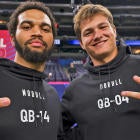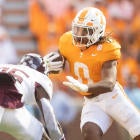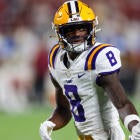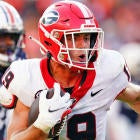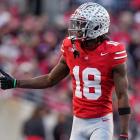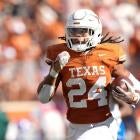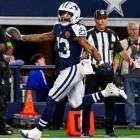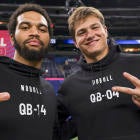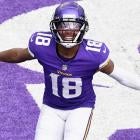It would be a disservice to you, the Fantasy owner, if the NFL Draft was ignored. That's why, for the past few weeks, I've taken time to dig into the top prospects at running back and wide receiver. Those positions happen to be very deep with lots of really good players. Chances are the ones covered here won't be the only ones who contribute to Fantasy lineups this fall.
I've also taken a look at the top two quarterbacks and tight ends. I chose to only look at the top two at each of those spots because those positions are thin on playmakers who will make an impact in Fantasy this year.
I'm just a guy who loves football, not some fancy schmancy scout. So the ones I like are the ones who looked the best in the TV cutups I saw at DraftBreakdown.com. Of course, I did consult Dane Brugler's 2015 NFL Draft Guide, but only did so after watching players first. All of this will lead to rankings of prospects as we head into the draft. The rankings after the draft will look different based on where the prospects landed and what roles they could get right away.
Quarterbacks
1. Jameis Winston, Florida State: If you focus solely on the on-field stuff, Winston has the makings of a Pro Bowl quarterback. He has a big arm and can make every throw. His decision making wasn't close to perfect in college but he did play well in crunch time, which cannot be ignored. Winston is willing to make tough throws, which is why he had some interceptions. But I especially liked how he was rarely flustered by the pass rush. Plus he's a big fella, about the same size as Matthew Stafford. When you consider his off-field issues he becomes a bigger risk but teams might believe those could be contained. 1st round pick.
2. Marcus Mariota, Oregon: I think Mariota will be great in the system he ran at Oregon and will eventually be great in an NFL system too. He has the second-best arm in the draft, occasionally missing throws. At Oregon he didn't have to make a ton of reads whereas in the pros, he'll have to. Mariota has a quick release and can throw accurately while on the run, which is big. If he can play as cleanly and without thinking in other systems as he did in Oregon's, he's going to be a great quarterback, especially if he keeps extending plays with his legs. 1st round pick.
Running backs
1. Todd Gurley, Georgia: Gurley is the kind of home-run hitter that Chris Johnson used to be, complete with very good hands, quickness and much better size. And if you really need an idea of how fast he is, Gurley is a former Team USA World Youth Championship track runner! You might think that whoever takes him is taking a chance because he tore his ACL in November, but when's the last time a torn ACL torpedoed a running back's career? Hopefully he can avoid future injuries and become one of the best do-it-all backs in the league. 1st round pick.
2. Melvin Gordon, Wisconsin: It's a little bit by default but he's the most NFL-ready back in the draft (because he's not coming off a torn ACL like Gurley). Gordon has excellent size and speed. He had some help from a very good offensive line in college but he does a lot of the little things that make a running back great. If he did more inside running in college he'd be considered a complete back, but he's probably going to get to that point anyway. 1st round pick.
3. Tevin Coleman, Indiana: Coleman is a big, physical, fast running back. He has excellent field vision to go with breakaway speed. He's not always a patient runner (bumps into his O-line and gets tackled in the backfield) and he runs upright, but he has workhorse potential if he can scrape past a tandem situation sort of like Jeremy Hill did in 2014. With some coaching, Coleman could end up being a very productive player. 2nd round pick.
4. Duke Johnson, Miami (Fla.): Undersized but tough and definitely fast, Johnson is a very good fit as a back in a zone blocking offense. His ability to make quick cuts makes him even more dangerous. Johnson also kept wearing down defenses as games went on, which is considered a big plus. He has very good hands and is a threat on wheel routes. His burst is great but sometimes his vision isn't -- sometimes he out-ran his blocking. Ultimately he's a tough, compact runner who can make defenders miss. He'll likely begin working in a tandem but it might not be for long. 2nd-3rd round pick.
5. Ameer Abdullah, Nebraska: Abdullah has good burst and could be a dynamo in a zone blocking scheme thanks to his terrific cutting ability. He has very good hands and can make plays after the catch. If there's a big concern it's that he's small. He also isn't the best blocker, so he might not ascend to an every-down role right away. Could end up as third-down/passing downs back depending on where he's picked. 2nd-3rd round pick.
6. Jay Ajayi, Boise State: From what I saw, Ajayi was a tall back with a good second gear that didn't show up as often as I would have liked. He also didn't push the pile or break tackles enough for a guy his size (nearly 6-foot, 221 pounds). Ajayi ran with great balance and very nimble feet that helped him excel in the receiving game. He might have the best hands of any back in the class. But if he's going to be a great passing downs back, he must improve his blocking or he won't play a ton. He's also an upright runner, which leads to lots of hits and injuries. That's not good for a guy who reportedly has knee problems. 3rd round pick.
7. T.J. Yeldon, Alabama: The dude is a beast with good vision and patience but I'm not sure if his size will help him as much in the pros as it did in college. He has good speed, especially for his size, but he isn't a burner. On the plus side, he's better at pass protection than a lot of backs in the draft, and that will help him get on the field sooner. 3rd round pick.
8. David Cobb, Minnesota: Cobb is compact but physical and strong. I like his feet a lot. Cobb has nice burst when the hole's there, but if he doesn't see where he should go then he's trouble. He'll try to push for extra yardage but doesn't have the strength to get it very often. He was pretty effective on receptions, showing good acceleration after the catch. Cobb might need a good offensive line to really make his skills stand out, and his pass protection is average at best. 4th round pick.
9. David Johnson, Northern Iowa: Johnson's going to end up being a passing downs/goal line back a la Fred Jackson -- but the Fred Jackson version from roughly 2013. He is not fast nor quick, simply a big bully of a back who doesn't have a second gear. He runs upright and without quickness. His strengths are his route running and his hands. From what I saw he had more positive plays through the air than on the ground. He also can pass protect well. Pete Prisco called me insane when I suggested Johnson is better off as a receiver rather than as a rusher. 4th round pick.
Wide receivers
1. Amari Cooper, Alabama: Cooper has the size of Justin Blackmon, the big, 10-inch hands of Odell Beckham and the speed of Jeremy Maclin. And best of all, he's NFL ready. Cooper is an excellent, smooth route runner who can do whatever is asked of him and contribute right away. And while he has 4.4 speed in the 40-yard dash, he's just not quite the total package because he's not the very fastest or biggest. But he'll be a great contributor. 1st round pick.
2. Kevin White, West Virginia: Maybe I'm crazy, but I thought that White was a smidge underwhelming. The speed is there, as is the acceleration to the second gear. But it felt like he didn't always take advantage of his 6-foot-3 size or vertical jump. What he does have is size, which will cause problems for smaller cornerbacks. Harnessing his height properly will go a long way in making him a great receiver. He'll also have to improve on his technique running routes. Even though he's physical and willing to cross the field, he still could get better. His speed makes him better than Cooper, but his lack of polish keeps him behind Cooper in terms of being ready to contribute right away. 1st round pick.
3. DeVante Parker, Louisville: I like how Parker lines up everywhere and is willing to run any route. He's definitely a playmaker, creating a big play at least once in every game I saw. He was good last year but was better when Teddy Bridgewater was his quarterback. I also love how quickly he can turn to get open at the top of his routes. He can jump and high-point the ball to make big plays as well as make catches in traffic. If there's a knock it's that he's lean and could get knocked around in the pros. 1st round pick.
4. Nelson Agholor, USC: One of my favorites. Agholor doesn't have dominating height or size but is definitely one of the best receivers in this draft. He plays violently, like his hair is on fire (sometimes to his own detriment). He has excellent hands and a sweet catch radius for a guy his size (6 feet, 198 pounds). He has incredible quickness, can cut on a dime and can change directions quickly with a pretty dang good second gear. He'll also contribute on punt returns and is one of the better blockers among receivers. He's also really intelligent. Agholor reminds me a lot of Chad Johnson. 1st round pick.
5. Dorial Green-Beckham, Missouri: DGB has the height of Calvin Johnson but not quite the muscle nor the speed. It's not like he's slow, but he will get caught from behind. His hands also aren't the best as he'll body catch some passes and drop a couple of others. He also need to learn how to win 50-50 balls in the end zone as he didn't always leap and use his size effectively. That technique could be coached, but the biggest factor is what he's like off the field. Is he going to be a problem like he was in college or will he not mess up his chance to be a great pro? Ultimately Green-Beckham has great size with good speed. 2nd round pick.
6. Phillip Dorsett, Miami (Fla.): If he had Breshad Perriman's size he'd be the best receiver in the draft. Dorsett blends incredible speed with quickness and, I believe, good route running skills. He's got fantastic hands and seems to already understand so many nuances of the game. He's got it all -- except he's small at almost 5-foot-10 and 185 pounds. If a team like the Saints (indoor team with a big-armed quarterback) gets him, he'll be a candidate for 1,000 yards by his second season. 2nd round pick.
7. Breshad Perriman, UCF: This is a height/weight/speed prospect, meaning he looks the part at a muscular 6-foot-2 and 212 pounds. Perriman can fly, and he's quick to shift his feet too. Much has been made about his hands -- sometimes he adjusted to a poorly thrown ball and snared it, sometimes he dropped passes aimed perfectly. There is some concern that he used his athleticism and size to do well in college, and sometimes that doesn't translate to the pros. He has a world of potential but it'll come down to who's teaching him off the field and who's throwing to him on the field. 2nd round pick.
8. Devin Smith, Ohio State: Smith is a complete wild card. He might just be the smoothest runner and best deep-ball receiver among his class. But his hands are undersized and you can tell he had trouble making catches all last season. Smith reeled in a bunch of over-the-shoulder and deep balls thanks to his speed, concentration and long arms but often had to trap the ball with his helmet/chest. He also dropped a bunch of passes. And while Smith dominated on deep go routes, he didn't run a lot of other plays, which he'll have to learn. He's got the speed you want, the wingspan you want, the experience you want, comes off as mature and seems to play bigger than his size (6-foot, 196 pounds), but the hands, awareness and blocking could hold him back. 2nd-3rd round pick.
9. Jaelen Strong, Arizona State: Tall (6-foot-2), good size, wide wingspan but doesn't play fast. He'll line up anywhere, run any route (nice fade route receiver) and is especially good on routes 20 yards or less. Strong can high point the ball better than other rookies in this draft. He's just not explosive, which saps some of his draft stock. He could fit in right away in Philadelphia's system, which is probably the best fit for him. 2nd-3rd round pick.
10. Rashad Greene, Florida State: He's not the biggest or fastest receiver in the draft but he has to be considered among the most NFL-ready. His route-running and jumping ability especially stand out. Greene has quick feet but is slow to reach his top speed. Fortunately his hands are pretty good, though he'll occasionally drop some and body-catch others. He also seemed to struggle more often versus man coverage. Greene seemed confident and intelligent in press conferences and focused on the field. He's going to be good in West Coast offenses but his size will keep him from being a priority in the draft. 3rd round pick.
Tight ends
1. Maxx Williams, Minnesota: Williams is your prototypical big tight end who is a better blocker than pass catcher. He's a mauler who rarely doesn't lay the smack down on a block. His hands weren't bad either but he has next to no speed to his game. He's not quick, nor can he separate from linebackers. He's going to be dangerous in the red zone but that's about it. 2nd round.
2. Clive Walford, Miami (Fla.): Walford is a good player, but he's not a great player. He doesn't have the speed to be unique, just the size (6-foot-4, 250 pounds). He has big hands and could develop his route running to become a better receiving threat. And Walford's blocking ability is good but it's not great. We won't mistake him for Jimmy Graham. 3rd round.













